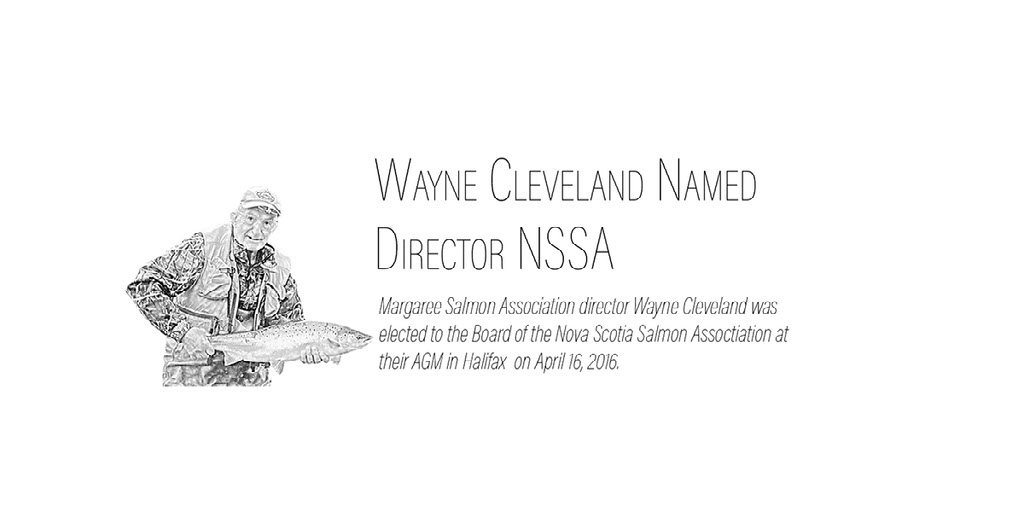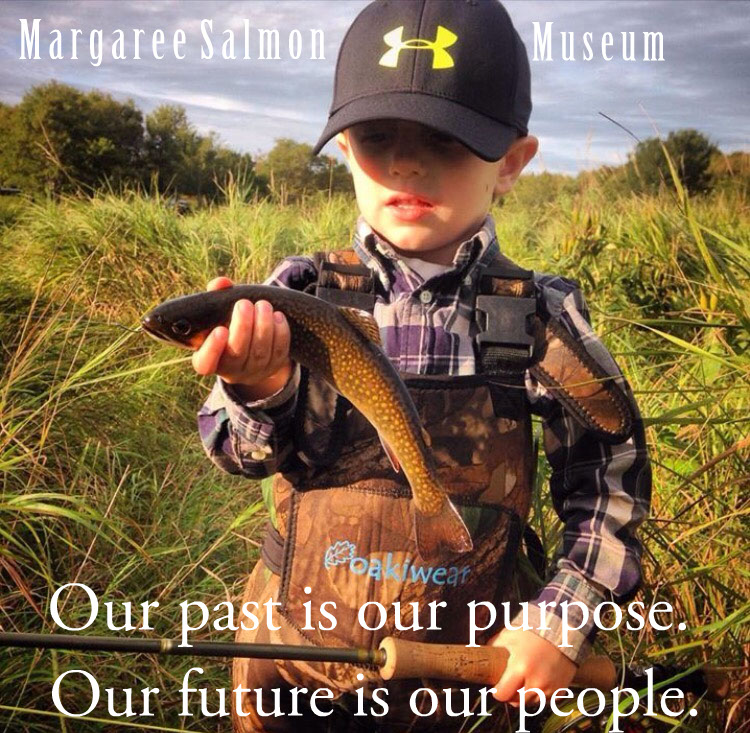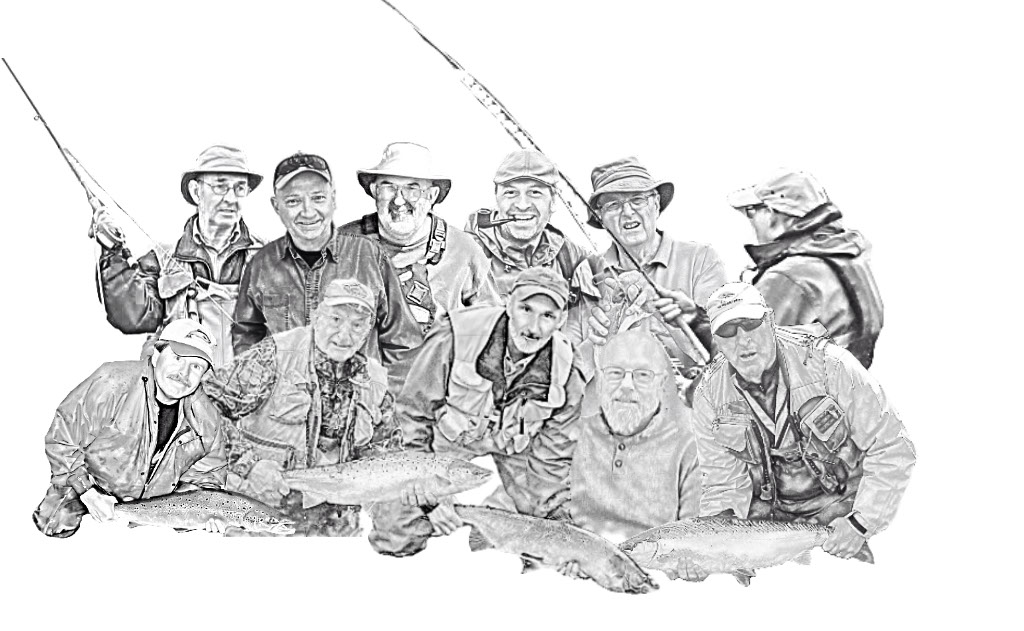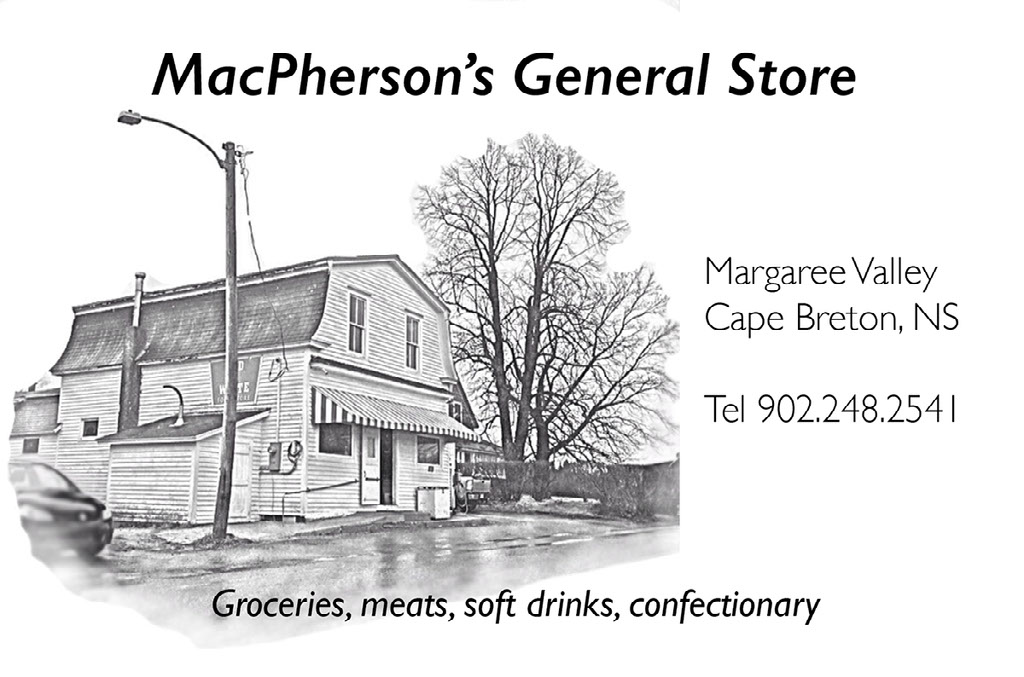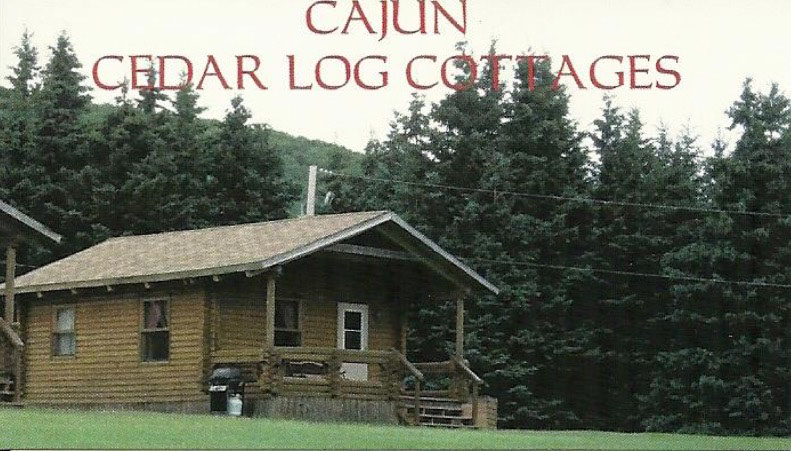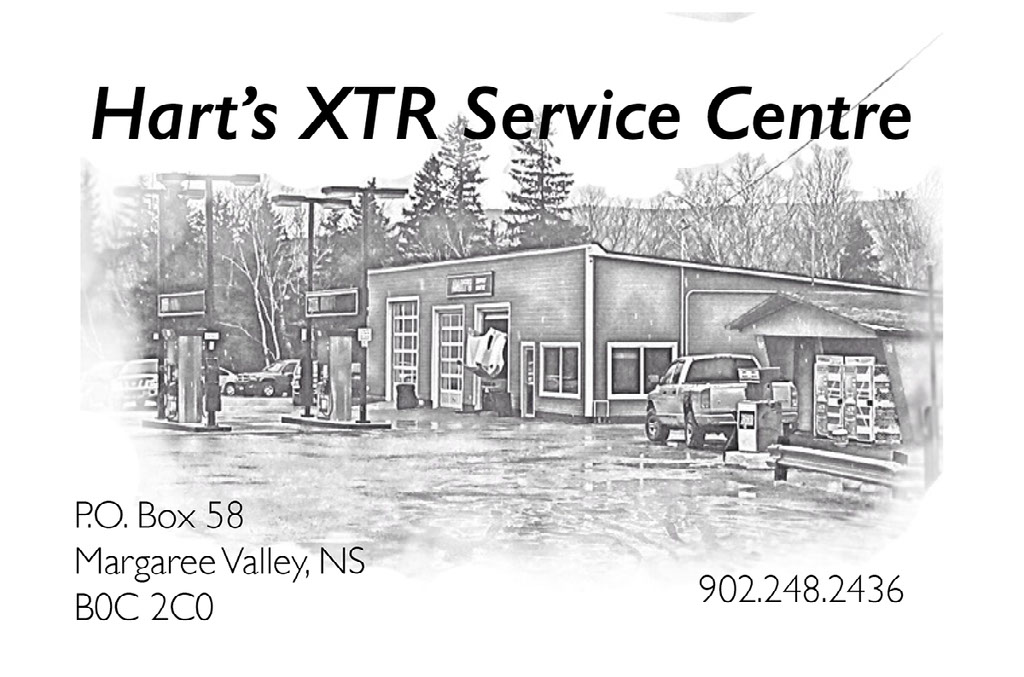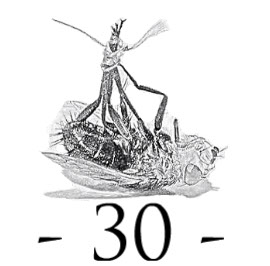margaree salmon association Spring 2016 Newsletter
Cover: Houses at Margaree Harbour oil, 61x91 ~ Joy Laking www.joylakinggallery.com

The winter has not been harsh and the spring run from the highland snows has not been wild – yet nevertheless quite high. Hopefully a good sign for the fishery this year.
With a near full board, we have been working through the winter coming to grips with the organization required to offer full service to the membership. It is interesting and stimulating to sit around a table with a group of diverse people exchanging ideas.
Vice President Bill Haley and I presented at two federal committees. I had the great pleasure of meeting Federal Fisheries Minister, Hunter Tootoo, who expressed interest in our activities.
Bill Haley spearheaded working groups with DFO and we hope such cooperation will foster continued support for MSA projects.
Today’s world of electronic communication is becoming the norm and MSA must move accordingly. We are continually adding to our website and are using Facebook to broaden our reach. To some of us this is a new world, but we must move in this direction to strengthen our support and membership.
Currently about half our memberships are “Life”. That means the annual operating costs of the association are borne largely by renewals. Please help us by ensuring you are up to date. We are financially sound and soon will share with you more information for future funding needs.
Our summer projects include Adopt-A-Stream, concentrating on renovation work in the tributaries. But we are aware the main river needs attention. In the past we have felt MSA lacked the strength to tackle the main branches of the waterway. However we now feel we can begin reviewing the pools, the banks, and the watershed on a broader basis.
We’ve hired a full time staff person for a six month period to co-ordinate the development of various watershed studies, giving a basis for a longer view.
We have leased our office for another year. We are also considering a future permanent home.
We look forward to seeing you through the season! You are warmly invited to the fall AGM and dinner auction on Thanksgiving Weekend.

Photo: Rich MacNeil
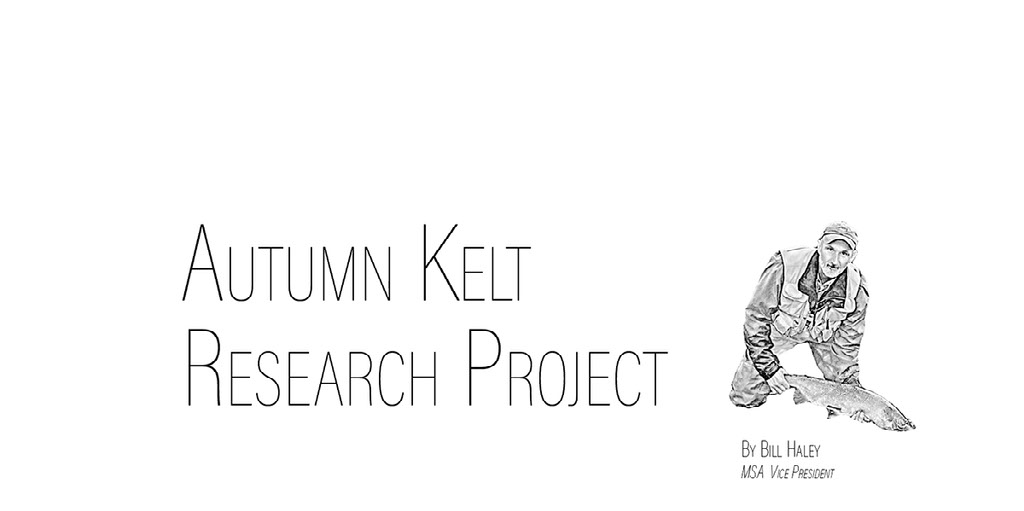
Jay-suss, this ain’t easy….
I was lumbering up a steep hillside, over a dusting of slippery snow, hauling a salmon in a protective water sleeve. Cripes, must be over 35 pounds...
After a brief surgery to insert a radio transmitting acoustic tag, I would then re-slip my steps to get this treasure back to the river as quickly as possible. There was, it occurred to me, real work in all this volunteer stuff.
We were working alongside Xavier Bordeleau, in year two of his Dalhousie University PhD research project tracking salmon kelts in the Bras D’Or.
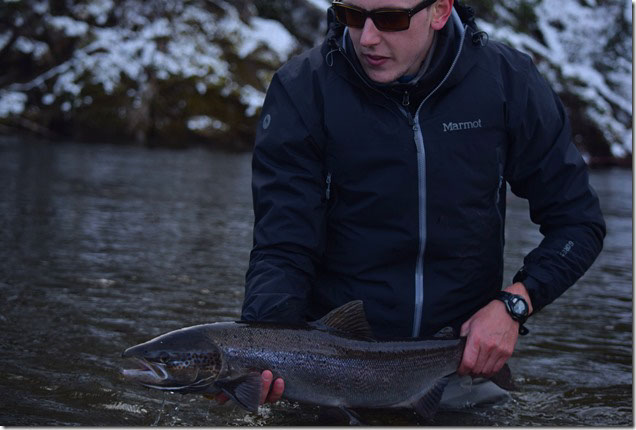
During the fall of 2014 Xavier had tagged spawned-out (kelt) salmon in the Middle and Baddeck waters and tracked them as they left the rivers, travelled through the Bras D’or Lakes and out into the Atlantic Ocean.
The acoustic tags are robust. They have a life expectancy of four years. This opens the exciting possibility of more research detecting the repeat spawners. Preliminary findings generally showed that salmon with smaller body masses left the river to resume feeding in the early winter while larger “fatter” fish over-wintered in the river and exited in the spring.
It is still to be determined if some salmon stay in the Bras D’or for their entire adult life – an intriguing part of this study.
Last year’s twenty-one tagged salmon included seven brood stock fish being returned by the Margaree hatchery, six fish caught by angling, and eight hatchery-spawned kelts tagged to the Baddeck River. Six of these twenty-one fish may have died during the winter in the river as there was no record of them passing the receivers placed at the river mouth. Another five fish went missing after entering Nyanza Bay, at the mouth of the river, during January/February 2015.
Xavier was determined to capture and tag more kelts in 2015. He asked if we (Margaree Salmon Association’s Leonard Forsyth, Greg Lovely and Bill Haley) would join ASF Regional Director Lewis Hinks in assisting his team. Without hesitation we agreed to help. Together, we added another forty kelts to bring his two year total to sixty-one.
Xavier had already organised a team of eight including several First Nations anglers. He also had the help of two graduate students, Danny Farrar and Leah Strople, for technical support. Danny graduated with a B.Sc. in Biology last April and Leah is a fourth year student studying Marine Biology.
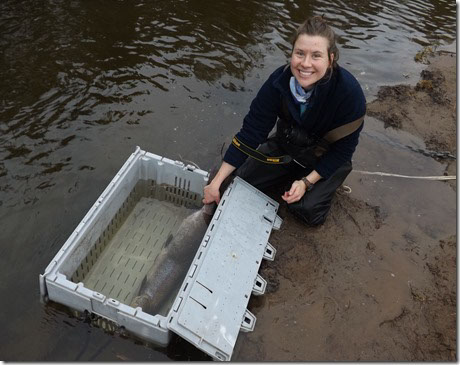
We began fishing November 25th and could fish under special licences until December 16th if needed. Xavier had 25 acoustic tags he wanted to implant surgically. We got off to a great start. Leonard and Xavier landed three salmon on the first day.
Each landed fish was sedated and the transmitter surgically implanted before the fish was revived. When ready, the salmon was carefully raced back to the river and monitored both visually and electronically to insure its safety.
The weather varied from snow flurries to bright sun, but most days were mild and made for comfortable fishing. Some fish were quite dark while others were bright and appeared to have recently entered the river.
By December 10th, all 25 tags were implanted in six male and nineteen female salmon. Forty salmon were landed: thirty-four females and six males. Extra effort was made to catch fair representation of male fish as only four of the first thirty-two salmon landed were males. These were general numbers, as Xavier and his assistants recorded the official, detailed records. Only one tagged salmon was re-caught, and this fish fought and jumped energetically with no sign of fatigue. Not a bad show for a post-op!
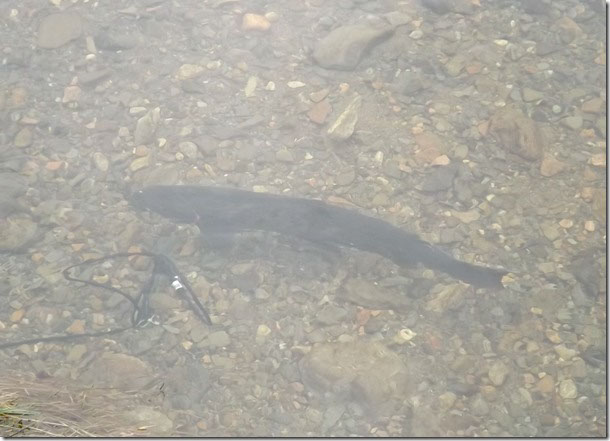
The receiver array that picks up signals from the fish was previously installed over a wide area: in the rivers, at the river mouths, in the Bras D’or, at the three exits points to the ocean, and offshore between Cape Breton and Newfoundland/Labrador.
I checked in with Xavier this past March and, not surprisingly, he had already been out on the water. He reported finding nineteen fish in the Middle River’s crystal clear water. However, out in Nyanza Bay and St. Patrick’s Channel on the Bras D’Or he detected no fish. The mouth of the Baddeck River was still ice covered, so details were not available there.
Xavier plans to continue tracking every month through the season and have the entire receiver array downloaded by August. To fully download the complete data set, a diver must physically retrieve the units. How long the receiver array remains out in the ocean is not known as it is outside the control of Xavier’s project.
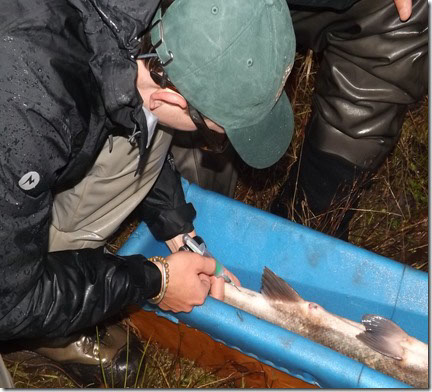
Our best environmental decisions come from good science. We eagerly look forward to his final report, which should be out later this year.
From an angling perspective, we enjoyed the daily adventure of participating in this project. We also are looking forward to the Spring 2016 Kelt Project on the Margaree River – and to revisiting the 82 kelt salmon tagged at the hatchery in the fall of 2015.

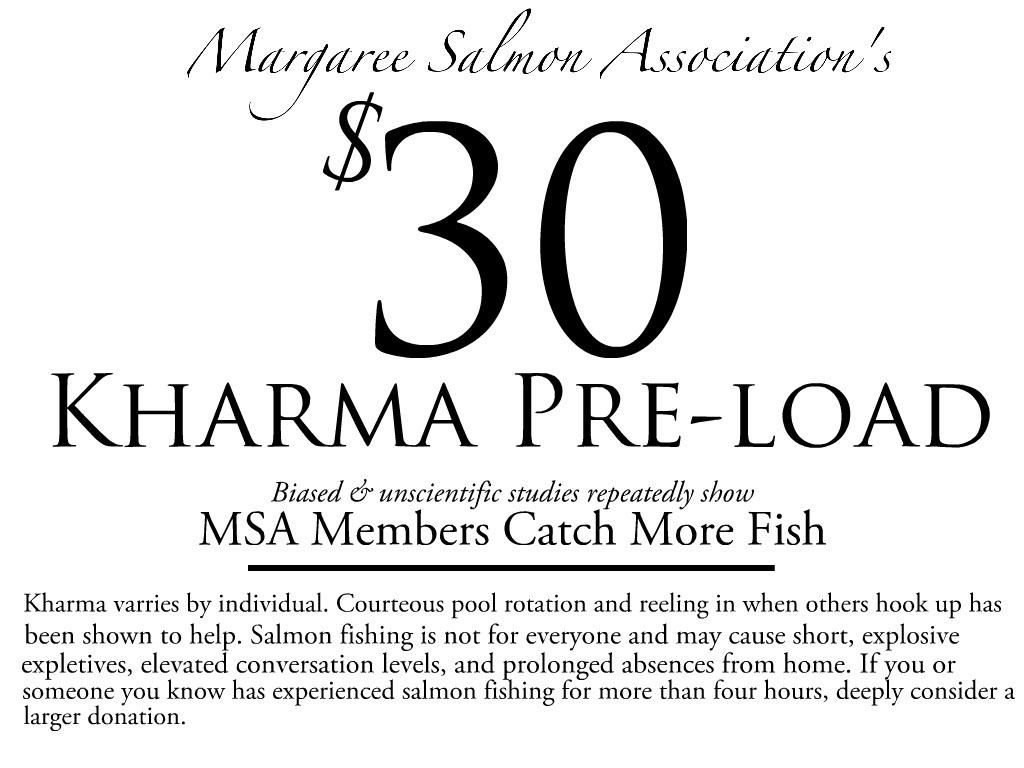
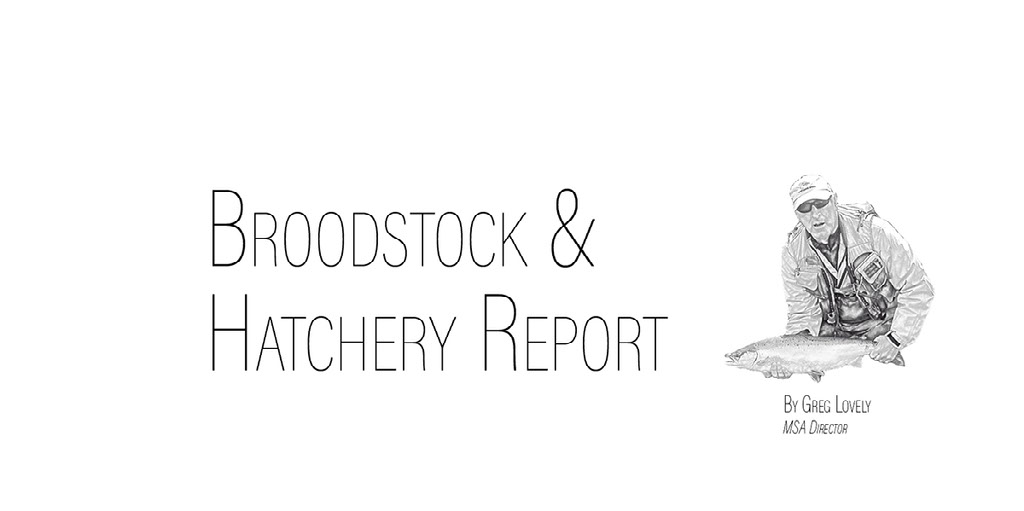
“Awesome, the power of nature...ah...wait a minute...didn't we just strip the milt out of that one?"
Indeed we had. After being, sized, tagged, and stripped, this buck was ripping up Ingraham's Brook from the Hatchery Pool like some Halifax bar scene drunk, all hotted up for that oh-so-important last date of the night...
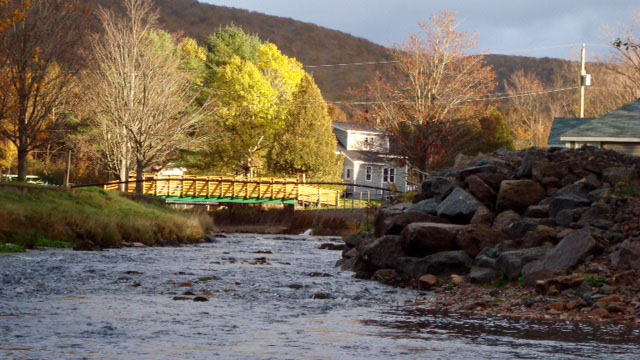
This was back in November. I had dropped by the Margaree Hatchery and found the broodstock we helped capture from Doyle’s Bridge Pool in August were still on hand, along with additions from the Middle, Baddeck and Mabou rivers.
Each rivers' broodstock were kept in separate tanks to protect their genetic integrity. I had the opportunity to view the process of spawning these fish. It was fascinating. The salmon were sedated using a mild neurotoxin to make handling of the fish easier and safer. Then they were weighed, their lengths measured and scale samples taken. Eggs and milt were then extracted.
Afterwards, they were tagged and released - hence our punch drunk grilse - just one of the 80 or so fish marked this year for next spring’s Department of Fisheries Kelt Research Project.
MSA will assist DFO in capturing kelts again in 2016. Should you happen to come across one of the small green tags on a dorsal fin of a salmon, please report the number to Bobby Ingraham at the hatchery (902) 248-2845.
Back inside the hatchery, samples of unfertilized eggs were labeled to be sent up to the Agricultural College in Truro. Careful records are kept, so if a batch of eggs does test positive for disease, they can be removed from the genetic pool. After fertilization, eggs are then carefully monitored until March when they hatch out.
I returned to the hatchery this past March - and what a wonderful surprise. Thousands of tiny alevins swimming about with their yolk sacks attached!
On average, 18% of the fish returning to the Margaree are hatchery fish. This is tracked by clipping the adipose fin (yep, with scissors, thousands upon thousands of times by hatchery staff and MSA volunteers). Stock are clipped in November through February and released into various spots around the river.
In total, we clipped about 65,000 parr over six or eight clipping sessions. Thousands of smolt are also released annually, along with more than 200,000 trout fry.
This was my first time witnessing and assisting all this work at the hatchery - and it was a fantastic learning experience. The MSA supports and thanks the hard working, professional staff at the Margaree Hatchery; Bobby Ingraham, Andrew Morrison, John Carrigan and Wendy MacEachern.
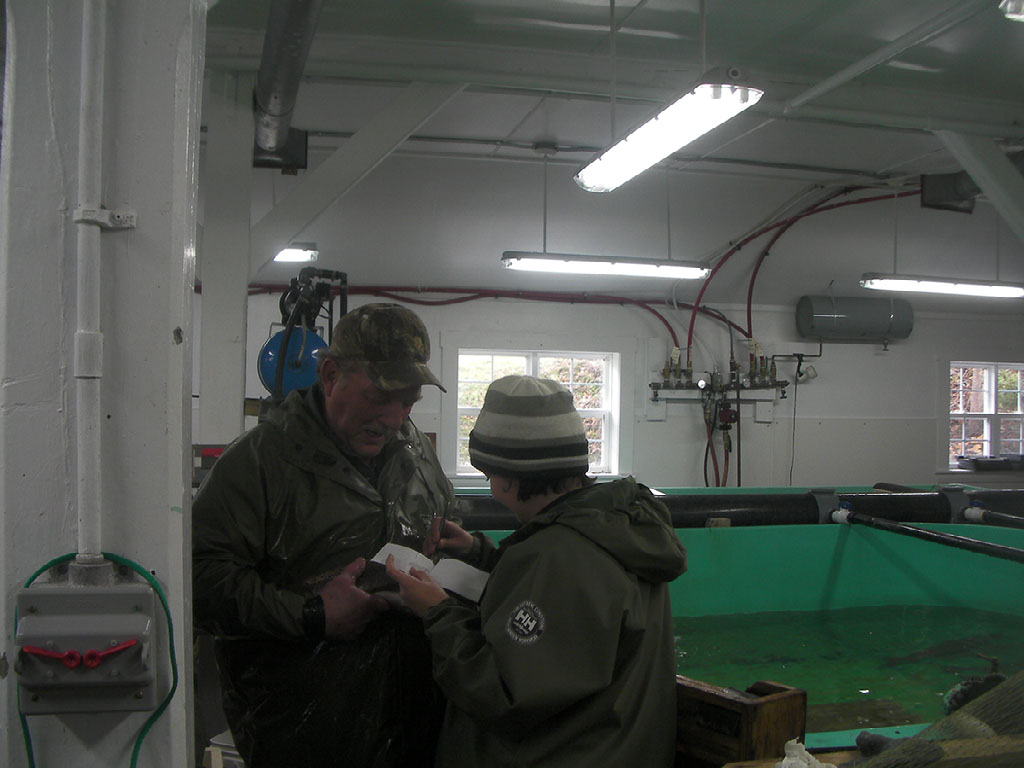
The Margaree Hatchery plays a big part in ensuring the future of Atlantic Salmon and Brook Trout on the Margaree and other waters in the area.

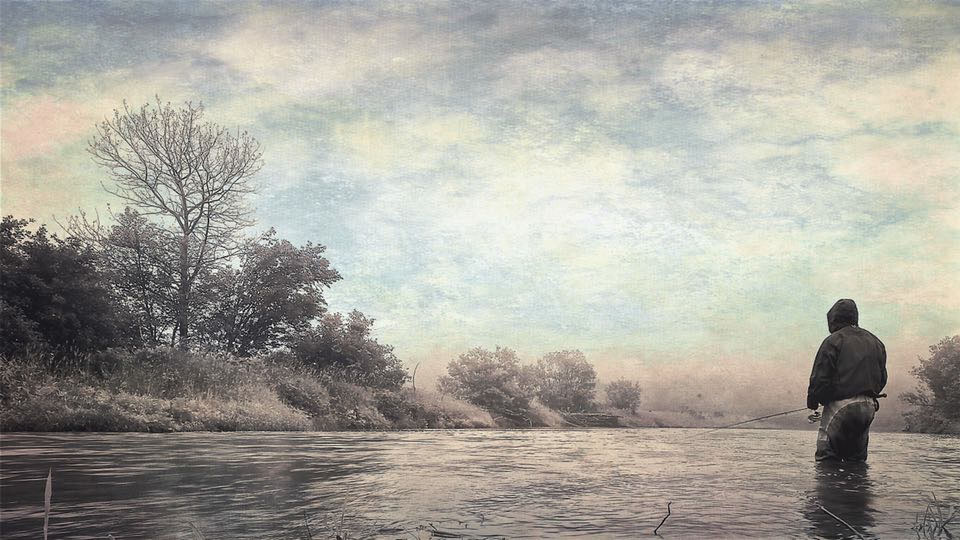
Dear Minister....
Honourable Minister Hunter Tootoo
Minister of Fisheries, Oceans and the Canadian Coast Guard
Dear Minister Tootoo:
Re: Resolutions on Recreational Fishing passed at the Annual General Meeting of the Margaree Salmon Association, held last fall in North East Margaree, Cape Breton Island.
I have been directed to forward you the following resolutions. We have brought them forward at Governmental and NGO meetings held in this area but we wanted to be sure that DFO was in receipt. I am forwarding by e-post and sending hard copy to House of Commons as well.
Please find below resolutions resulting from the fall 2015 Annual General Meeting of the Margaree Salmon Association:
1. To ensure anglers targeting Atlantic Salmon purchase a Salmon License and complete the associated catch and effort log (stub return), that all persons angling during Atlantic Salmon season on the normally scheduled portion of the Margaree River system be in possession of a valid Atlantic Salmon fishing license.
2. To promote healthy lifestyle activities, that all provincial and federal recreational fishing licenses be available at a reduced seniors fee rate to anyone 55 years of age or older.
3. To protect kelt salmon exiting the NE and SW branches of the Margaree River each spring, that the opening of trout season on the normally scheduled portion of the Margaree system be delayed until May 15 each year. In addition, that the Atlantic Salmon season open on May 15 each year and that only approved artificial fly fishing methods be used for angling these waters at any time.
4. That the Department of Fisheries and Oceans make regulatory changes, so that the angling of striped bass in the Southern Gulf of Saint Lawrence take place from May 1 to Nov 30 each year, and that an angler may retain 1 fish of any size each day.
Sincerely,
Lester Wood
President
Margaree Salmon Association
c.c. to Rodger Cuzner, Cuzner1@parl.gc.ca
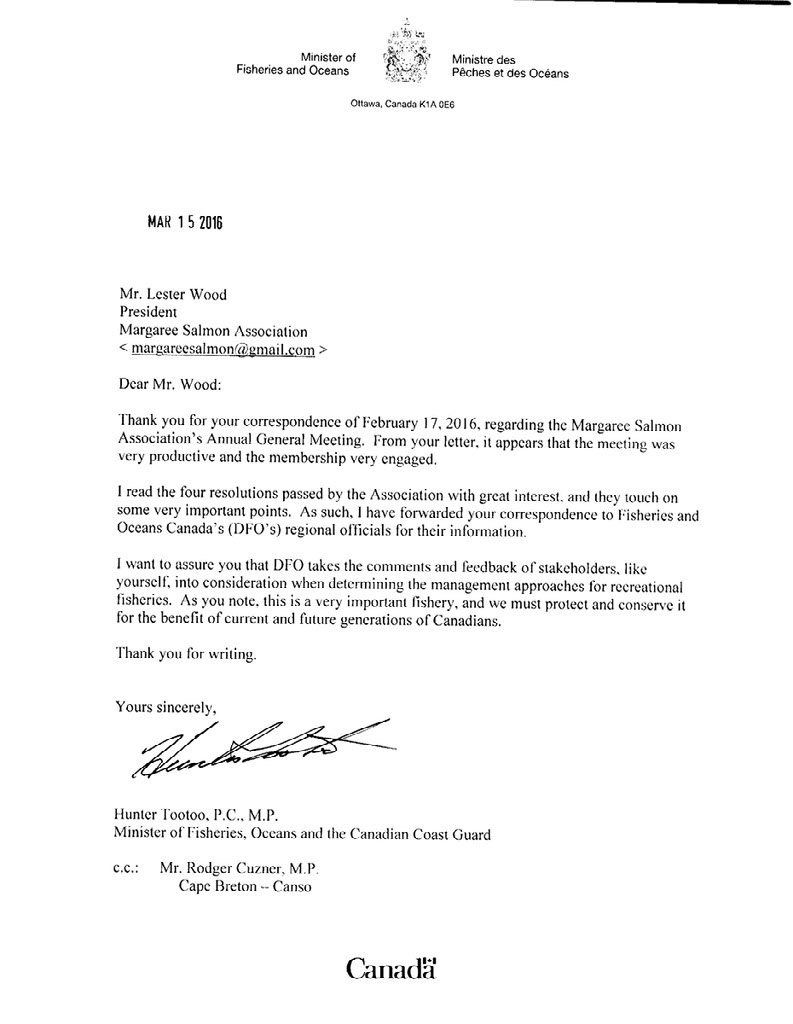

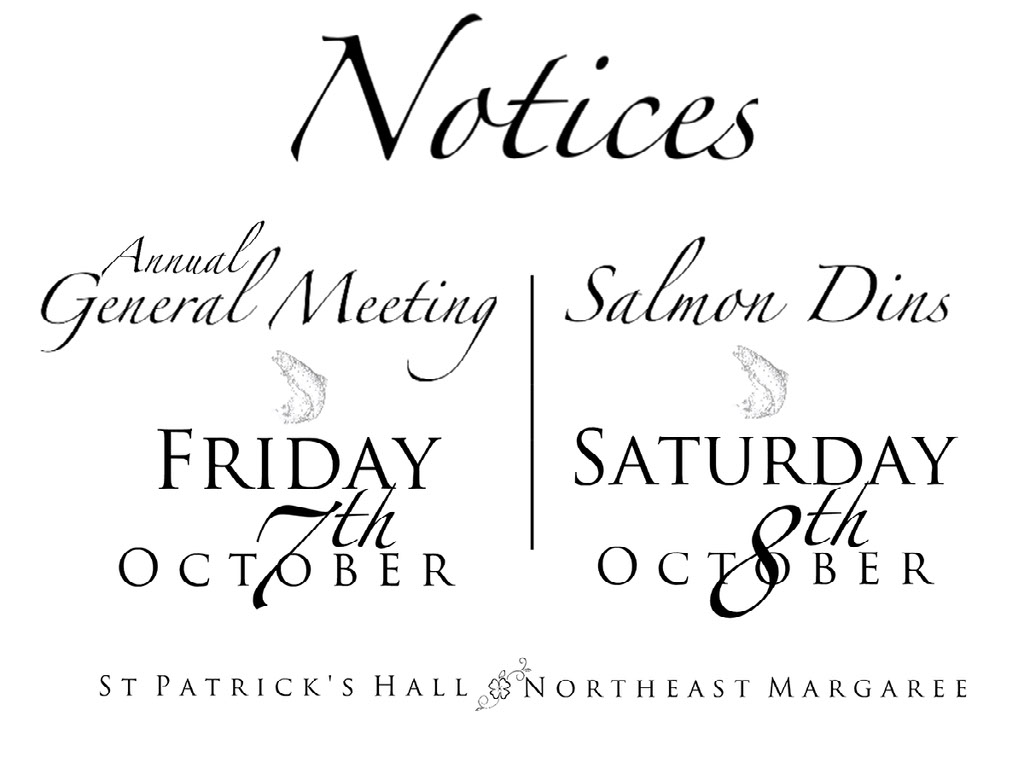
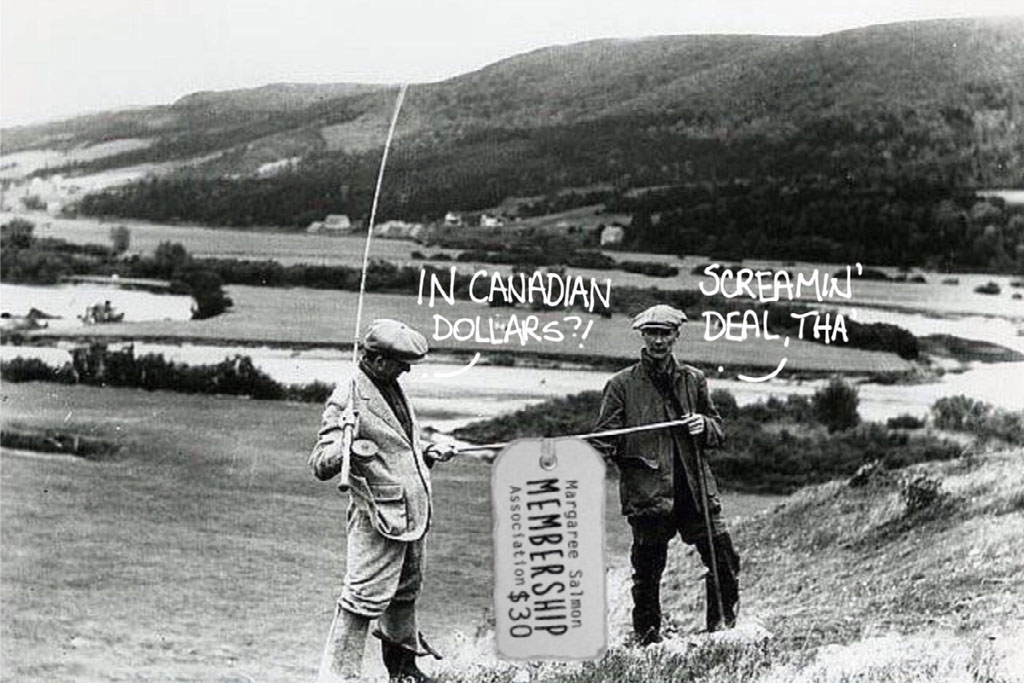
The Margaree's FISHING SPIDERs
By Donnie B
Okay so Bill asked me to write about fishing spiders. Some of this is from Google, but mostly it’s stuff I’ve observed out on the river, just by watching.
They are all over the river. In the woods, too. Down on the forest floor. They don’t use webs for hunting, but mainly for nests and raising their young. You see those a lot early mornings in August and September, all over the place, covered in the dew. But mostly you see the spiders themselves out on the shingle.
They’ve got eight eyes, two sets of four. One row on top of the other and curved a bit. They see real good, that’s why they dart about when you get close to them. You see them sitting there and then they flit into a crack between the rocks just like that. Tan and black stripe, large tan one down the centre, prominent like.
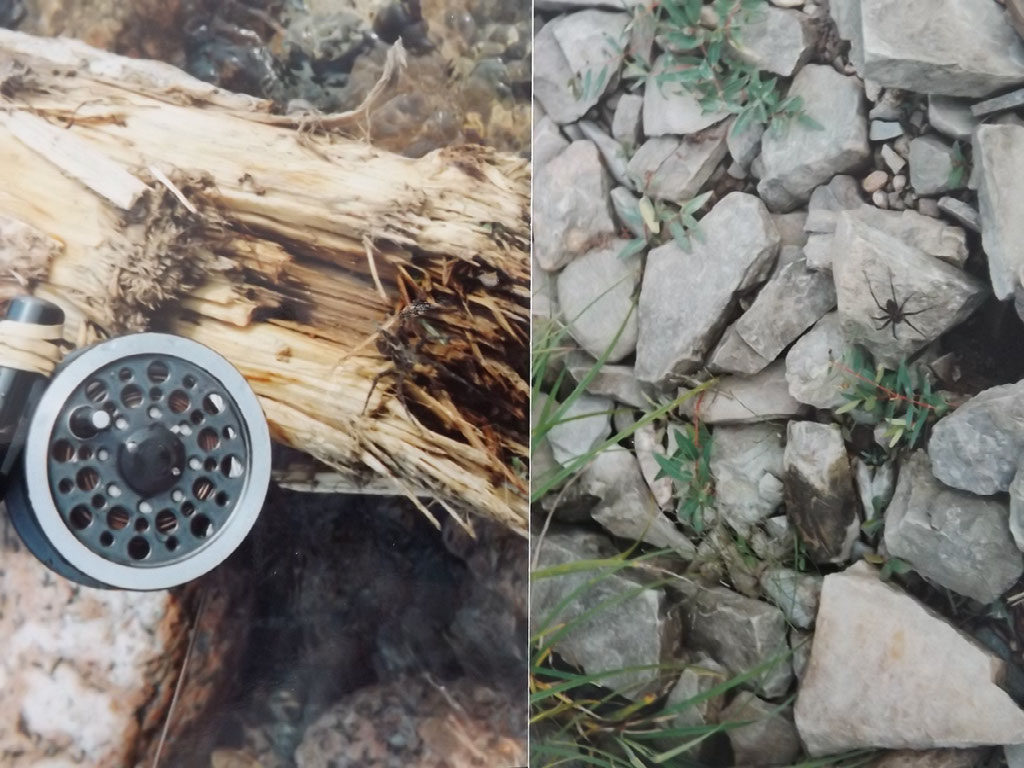
Snakes eat them, and birds. But also wasps, who sting them and lay eggs in their bodies. Eat the spider from the inside out. The wasp larvae I mean.
They eat fishermen. No they don’t haha, but they are big for spiders. Three, four inches across. They eat other insects, but also fish when they can get them. Think I have a Youtube of that somewhere.

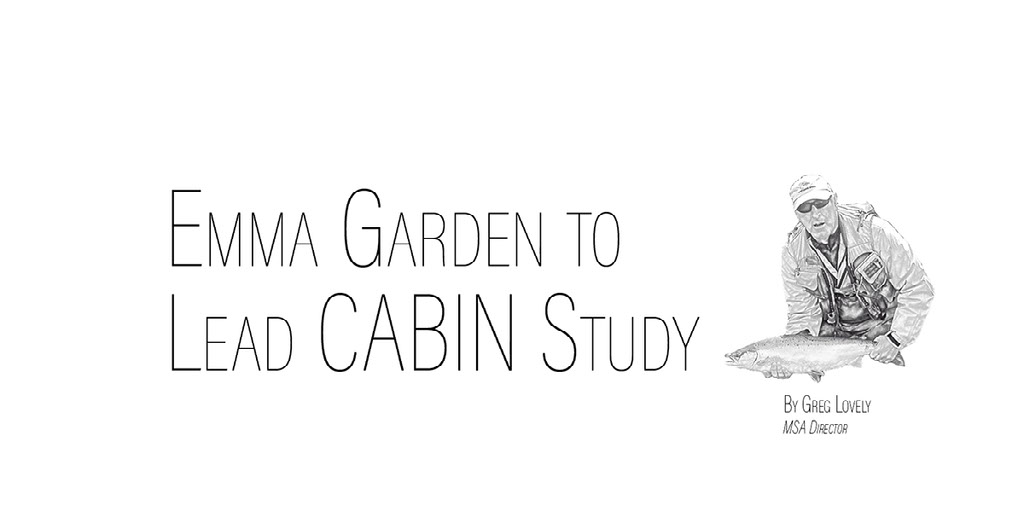
Unama’ki Institute of Natural Resources’ researcher Emma Garden will lead a CABIN study of the Margaree this autumn.
CABIN stands for Canadian Aquatic Biomonitoring Network. This is a standardized study of watersheds across Canada. What’s significant is that CABIN results are stored on a common database providing further research opportunities for us, and allowing others to use our findings.
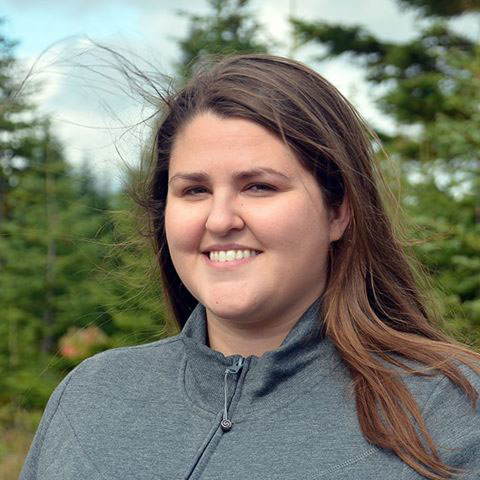
Our study will be on the Benthic zones of the river – the bottom layers. Here Emma will concentrate on measuring the types and numbers of invertebrates. Water quality will also be assessed. For example, Emma will track acidity and dissolved oxygen levels along with phosphorus, nitrogen, and silt. You could say it's really about the food in the river.
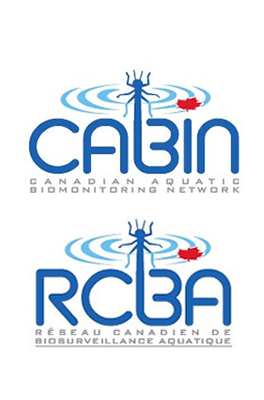
Our CABIN study is made possible with the generous donation from members Graham and Susan Smith. MSA is joining up with the South Inverness Angler’s Association to set up and monitor five sites on the Margaree, and several more on rivers near Mabou.
In 2015 Emma studied seven Unama’ki (Cape Breton) rivers, and her results are impressive and encouraging. Our waters are clean and productive.
Emma holds a Master’s degree in Water Resources Engineering from the University of Guelph in Ontario and a BSc in Environmental Studies from Saint Mary’s University in Halifax. She is a certified aquatic insect taxonomist.
We look forward to seeing the results!

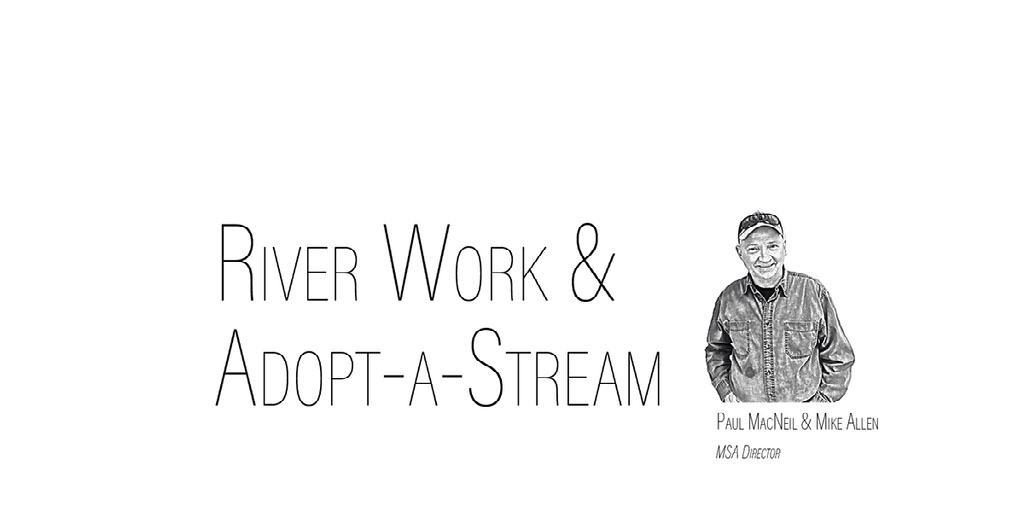
It was the first nice day in April, and I stepped down off the road by Doyle’s Bridge. Or at least where the second Doyle’s bridge used to be. Turned out this was not the best route to the river. Silty, clogged, full of organic debris. The way I was high stepping, it felt more like I was doing some sort of river yoga.
The pools below the bridge have been changing in the past few years, undecided as to where they want to go. Fence Run has fished at times in abundance, at others times a void. People worry about the river getting out of control. They wonder what can be done about it.
There certainly is evidence strewn about the river – cables, logs, slipped rock-fills – enough to suggest that trying to redirect the main flow is harder than it looks. Over the past twenty years or so it has become clearer that what affects the river happens mainly on the streams and tributaries that feed into it. That the best way to fix up the river is to fix upriver.
Examples of this aren’t hard to find in nature. Winds and moisture swirl in ways that surprise us with the most delightfully intricate snowflakes. In the fall and spring we watch hundreds of starlings swirl in flowing murmurations. Each bird compelled to stay with the flock, while at the same time trying like crazy to avoid collision with the one next to it.
And so too with the Margaree. What starts as an efficient route for water to get from the Highlands to the Gulf of St. Lawrence, somehow transforms eddies, currents, and stones into complex pools, compound curves and vistas that makes us stop, turn and stare at the beauty.
This is emergence. The physical process where large complicated things come out of small simple ones without any obvious connection at all.
MSA will invest $58,405 into the river in 2016, primarily in our tributaries. Down by Margaree Harbour where the river is more agricultural, marsh and mixed forest, we’ll be working on channelling Scotch Mill Brook. For almost a kilometre we’ll shore banks, install both diggers and diverters.
Off the Southwest Margaree we’ll work on primarily trout areas in Captain Allan’s Brook for about half a kilometre. The work here is confined by the largely forest area, so we’ll be using hand power saws and tools. We hope to get in as many as seven diggers/diverters.
Back on the Northeast Margaree we’ll continue work in Marsh Brook. We’ll work about three quarters of a kilometre of the Timmons valley, largely in farm or marshy areas. Some work here may need the use of an excavator, and possibly a rock wall. With good conditions we may get as many as nine diggers/diverters installed.
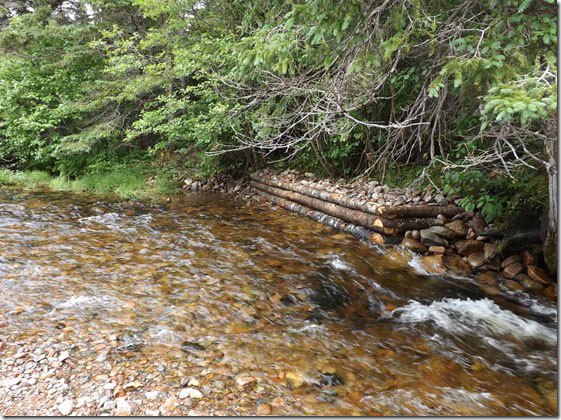
As we add structures to these tributaries over the years, it’s worth noting that they are depreciating assets for the river. But with active maintenance we can extend their useful life significantly. We’ll be filling holes in our schedule with maintenance through these areas and other existing structures in our watershed.
Again we hope to use over 400 volunteer hours and give more than 55 weeks of work in the area. We estimate that our efforts add more than $100,000 to the local economy.
Free flowing, naturally structured, and well oxygenated streams deliver clear flowing silt-free water to the Margaree. They also act as nature’s own hatcheries - giving the top biomass the rest of us so enthusiastically chase as “fish”.
Watersheds are large, complicated things. They are very difficult to wrap a master plan around. A few weeks ago I met with a friend who has been working on a master plan for his river on the mainland for over 20 years. He wonders if it's even possible. So maybe it’s best that we continue working on small parts of the area, noting carefully the effect of our efforts in succeeding years. Perhaps our efforts are best when allowed to emerge into a greater plan – even if we only see the plan clearly years from now.
Do you have a question or suggestion for the river? Please join in our discussions and decisions. Let us know if you are able to help with costs, or time or equipment. Add in something that fits, piece by piece into the emerging plan of our river.
But even if all you’ve done is read this far, then welcome to you! You too are now part, in some small way, of the Margaree’s Adopt-a-Stream program.

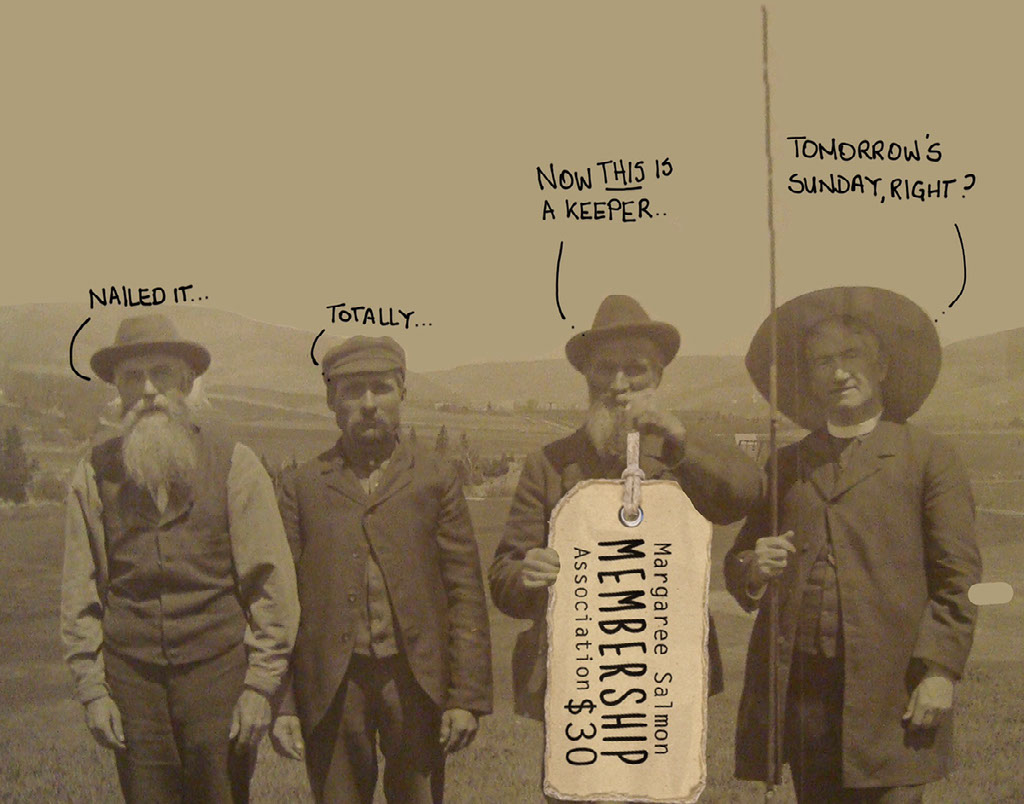

In late October we made our last cast for stripers for 2015. Leonard Forsyth, Greg Lovely, Gilles Paulin and Bill Haley fished the mouth of the Margaree River with fly and spinning gear. We landed six mackerel, including one half eaten by our only striper.
We fished for Dr. Cindy Breau's DFO Striper Diet Study in June (twice), July, August, and October. Over the year we caught 81 stripers under a special fishing licence.
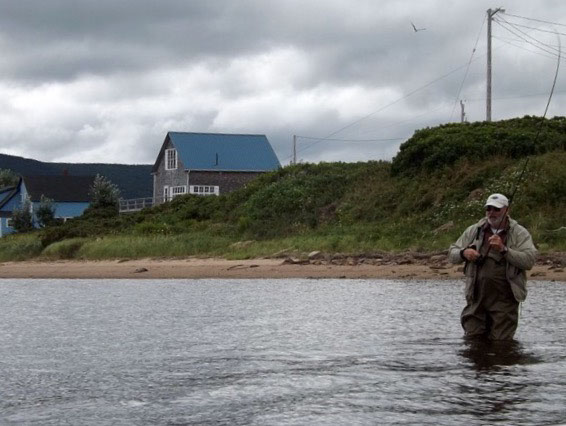
We await Dr. Breau's findings. Preliminary reviews suggest a diet of small trout, sliversides, mummichogs, and green crabs.

Photo: MSA member Rich MacNeil.

Dodi and I were fishing down low, Tompkins and below, looking for fish on the tide. It was the first warm day of the season, and we were in shirtsleeves. Dodi’s T-shirt said on the front, Saw my ex-wife from the bridge. On the back it said, not enough weight.
Kenny had already passed through, stomped up the shingle and plopped his carcass onto the bench. When we got there he said, “Of the forty kelts those Dal scientists took on Middle River last December, only six were buck.”
“Really,” said Dodi, “I heard they only got eight male in all them fish, the eighty they took out of Doyle’s last September. You know, for the hatchery broodstock.”
“Back in the 90s it seemed like only a third the fish we were getting were male grilse.”
“All gril now,” said Dodi. “I took 69 fish last year and only two were MSW males. Betcha three quarters of the fish were male gril.”
“Took or took and put back?”
“Smartarse. Put back.” Then, “I do miss takin’ them home tho’.”
Dodi nodded a question towards the head of the pool, and we nodded yes, and as he got up he said, “Somebody should do a count. Keep track of that stuff. Nice to know what the total males to females is. All year, like.”
Then he left us, walking up the shingle stopping only once to adjust his waders…


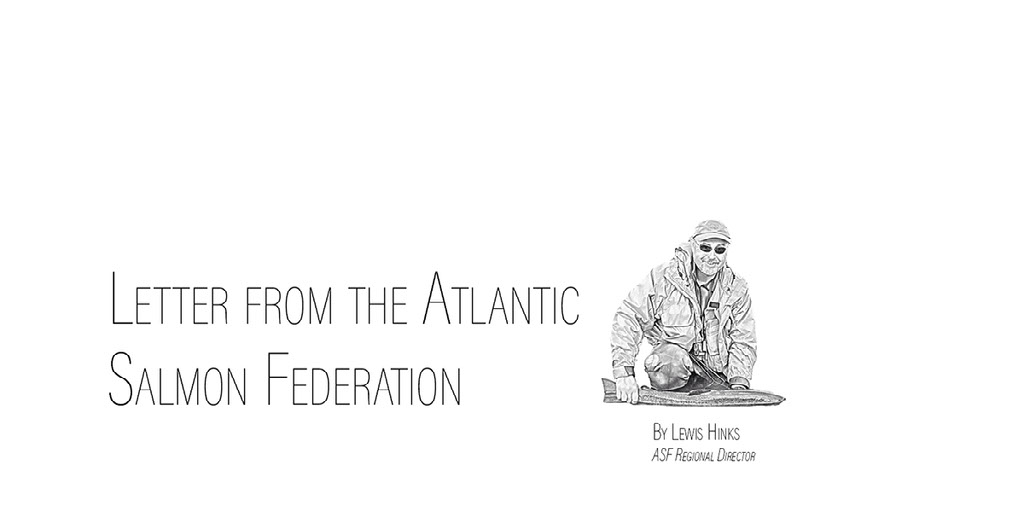
I have had the pleasure of working with the Margaree Salmon Association for all of the twenty-four years (and counting) that I have been working for the Atlantic Salmon Federation. I must say it has been a great working relationship during that time. It’s been an honour to work with such a dedicated group of volunteers. So many good projects: FLOW (Fishing Ladies Outdoor Weekend), Jim Campbell’s Barren and Fish Friends, to name but a few.
Recently I was fortunate to take part in some very interesting projects. The spring kelt survey, the striped bass survey and working with Xavier Bordeleau of Dalhousie University on a tracking study of kelts heading into the Bras d’Or Lakes, are all important pieces of river work.
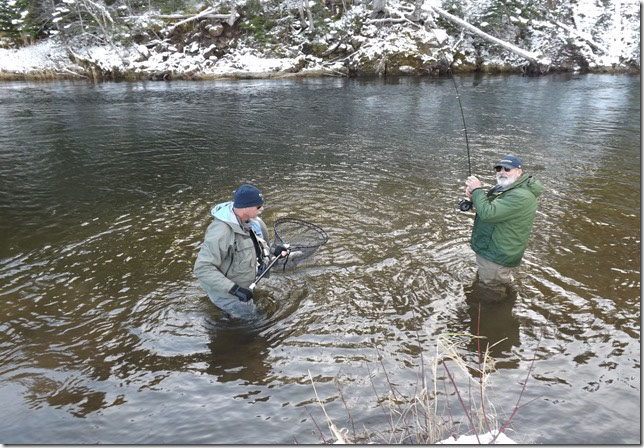
I had the absolute joy of assisting members of the MSA (Bill Haley, Greg Lovely and Leonard Forsyth) in the capture, via angling, of kelts for surgical implant of tags for the tracking study. A first for me, I was able to fish on my birthday in late November – without a doubt one of the best birthday presents I have ever received! Added to that thrill, was that this was done as part of a very interesting research project and I look forward to learning more about the results.
Thanks again, to the Margaree Salmon Association for all the great work you do for wild Atlantic Salmon in general, and for the Margaree River in particular. The river and its salmon are fortunate to have such a caring and dedicated group working on its behalf.
Please look at the ASF website www.asf.ca and learn more about us. For example, see our progress trying to improve the Federal Fisheries Act. : http://asf.ca/first-nations-scientists-and-conservationists-want-improved.html
